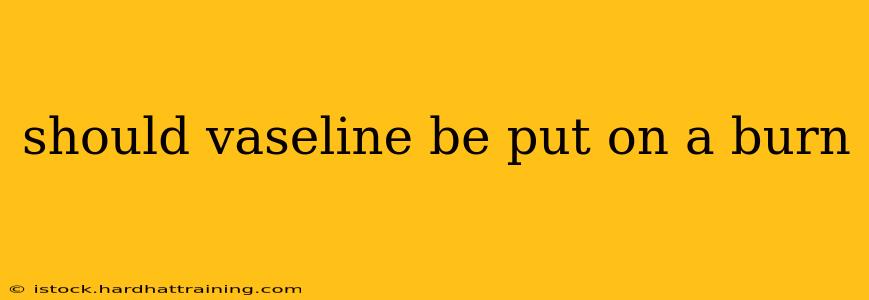Should Vaseline Be Put on a Burn? A Definitive Guide
Burns are a common household injury, ranging from minor sunburns to severe scalds. Knowing how to treat a burn properly is crucial for minimizing scarring and promoting healing. One common home remedy often considered is petroleum jelly, better known as Vaseline. But should Vaseline be put on a burn? The short answer is: generally no.
While Vaseline might seem like a soothing option, its application to burns is actually controversial and often discouraged by medical professionals. Let's delve into why.
Why Vaseline Isn't Recommended for Burns
The primary reason to avoid Vaseline on burns is the risk of infection. Burns damage the skin's protective barrier, leaving it vulnerable to bacteria. Vaseline, while seemingly sterile in its packaging, can trap heat and moisture, creating a breeding ground for germs. This can lead to a worsening of the burn and potentially serious complications.
Furthermore, Vaseline can hinder the natural healing process. Burns need to breathe and be kept clean to heal properly. A thick layer of Vaseline prevents oxygen from reaching the wound, slowing down the healing process and potentially increasing the risk of scarring.
Finally, Vaseline can make it difficult to accurately assess the severity of the burn. A medical professional needs to see the burn clearly to determine the best course of treatment. A layer of Vaseline obscures the wound, making assessment challenging and potentially delaying appropriate medical intervention.
What to Do Instead: Treating Burns Effectively
The appropriate treatment for a burn depends on its severity. Here's a breakdown:
Minor Burns (First-Degree): These burns affect only the outer layer of skin and are characterized by redness, pain, and mild swelling.
- Cool the burn: Run cool (not cold) water over the affected area for 10-20 minutes.
- Avoid home remedies: Refrain from applying Vaseline, butter, or other home remedies.
- Pain relief: Over-the-counter pain relievers like ibuprofen or acetaminophen can help manage pain.
- Keep it clean and dry: Cover the burn loosely with a clean bandage to prevent infection.
Moderate Burns (Second-Degree): These burns affect the deeper layers of skin and are characterized by blisters, swelling, and significant pain.
- Seek immediate medical attention: Do not attempt to treat this at home.
- Do not break blisters: Leave them intact to protect against infection.
- Cool the burn: As above, but only if directed by a medical professional.
Severe Burns (Third-Degree): These burns penetrate all layers of skin, appearing white or charred, and causing little to no pain (due to nerve damage).
- Seek immediate emergency medical attention: This is a life-threatening situation requiring immediate professional care.
When to See a Doctor
Always seek medical attention for:
- Large burns: Burns covering a significant portion of the body.
- Deep burns: Burns that penetrate beyond the outer layers of skin.
- Burns on sensitive areas: Burns on the face, hands, feet, genitals, or joints.
- Burns accompanied by other symptoms: Fever, chills, or signs of infection.
- Burns that don't improve: If the burn shows no signs of healing after a few days.
This information is for general guidance only and does not constitute medical advice. Always consult a medical professional for diagnosis and treatment of burns. Your health and well-being are paramount. Never hesitate to seek professional help when needed.
